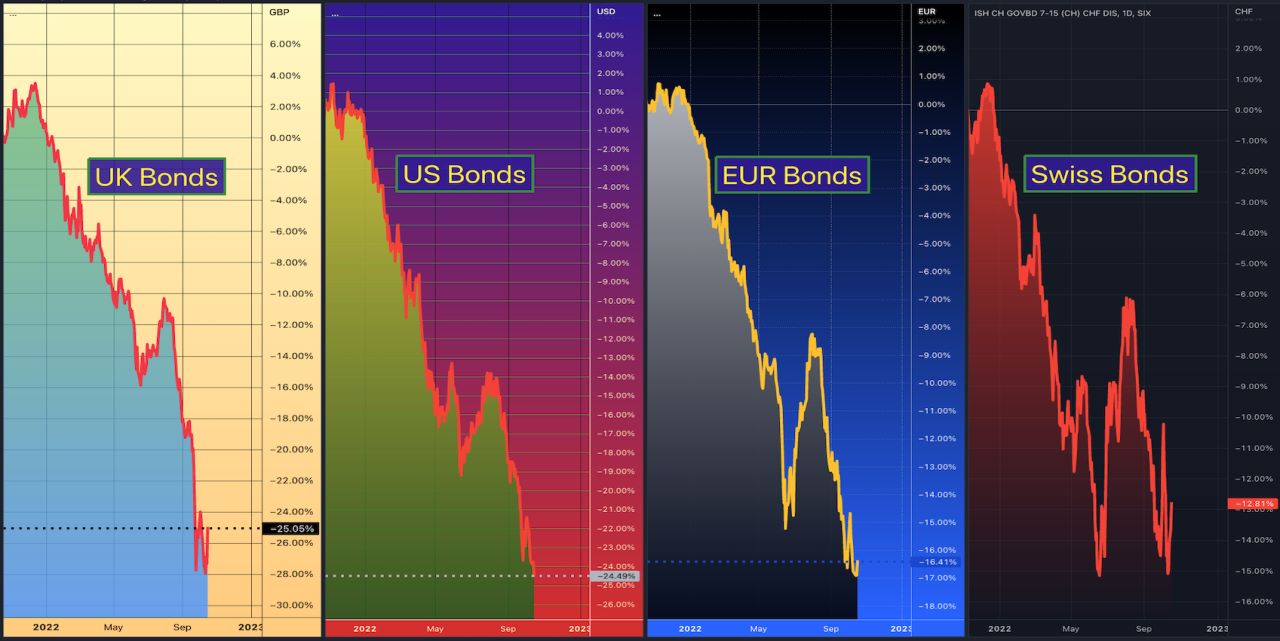

Finance
How Well Do Pension Funds Perform?
Published: January 23, 2024
Discover the performance of pension funds in the finance industry and make informed decisions about your retirement savings. Explore the latest insights and trends in pension fund performance.
(Many of the links in this article redirect to a specific reviewed product. Your purchase of these products through affiliate links helps to generate commission for LiveWell, at no extra cost. Learn more)
Table of Contents
Introduction
Understanding the Role of Pension Funds in Financial Markets
Pension funds play a vital role in the financial well-being of individuals and the stability of the overall economy. These funds are designed to provide a source of income for individuals during their retirement years. They are typically managed by financial institutions, investment firms, or government entities, with the goal of generating returns on the contributions made by employees and employers over the course of their working lives.
Pension funds are a cornerstone of retirement planning, offering a means for individuals to accumulate savings that can sustain them after they exit the workforce. The performance of pension funds is a topic of significant interest and concern, as it directly impacts the financial security of retirees. Understanding the factors that influence pension fund performance and the methods used to evaluate their effectiveness is crucial for both investors and policymakers.
In this article, we will delve into the intricacies of pension funds, exploring the factors that influence their performance, the methods for evaluating their effectiveness, and the challenges associated with assessing their performance accurately. By gaining a comprehensive understanding of these aspects, individuals can make informed decisions regarding their retirement savings, and stakeholders can implement strategies to enhance the performance and sustainability of pension funds. Let's embark on a journey to unravel the complexities of pension fund performance and its implications for the financial landscape.
Understanding Pension Funds
The Role and Structure of Pension Funds
Pension funds are investment pools that accumulate contributions from employees, employers, or both, with the aim of providing retirement benefits to employees. These funds are typically managed by professional investment managers, who allocate the pooled assets across various financial instruments such as stocks, bonds, real estate, and alternative investments. The overarching goal is to generate returns that will enable the fund to meet its future payment obligations to retirees.
There are two primary types of pension funds: defined benefit (DB) and defined contribution (DC) plans. In a defined benefit plan, the retirement benefits are predetermined based on a formula that considers factors such as salary history and years of service. The employer bears the investment risk and is responsible for ensuring that the fund can meet its future payment obligations. In contrast, defined contribution plans specify the contributions made by employers and employees, with the eventual retirement benefits depending on the performance of the investments made using these contributions.
It’s important to note that pension funds operate under regulatory frameworks that dictate their investment guidelines, risk management practices, and reporting requirements. These regulations are designed to safeguard the interests of pension fund participants and ensure the long-term sustainability of the funds.
Furthermore, pension funds play a significant role in the broader financial markets, as they are substantial institutional investors with the capacity to influence asset prices and market dynamics. Their investment decisions can impact the performance of individual securities and asset classes, making them key players in the global investment landscape.
By understanding the structure and function of pension funds, individuals can appreciate the mechanisms that underpin their retirement savings and comprehend the factors that contribute to their performance. In the subsequent sections, we will explore the intricacies of pension fund performance, shedding light on the various factors that influence their effectiveness and the methods used to assess their performance.
Factors Affecting Pension Fund Performance
Influential Elements Shaping Pension Fund Performance
The performance of pension funds is influenced by a myriad of factors that collectively determine their effectiveness in meeting the long-term financial needs of retirees. Understanding these factors is crucial for investors, fund managers, and policymakers seeking to optimize the performance and sustainability of pension funds.
- Asset Allocation: One of the primary determinants of pension fund performance is the strategic allocation of assets across various investment classes. The mix of equities, fixed income securities, real estate, and alternative investments significantly impacts the fund’s risk-return profile. A well-structured asset allocation strategy seeks to optimize returns while mitigating risk, aligning with the fund’s long-term liabilities and investment objectives.
- Market Conditions: Pension fund performance is inherently linked to prevailing market conditions, including economic growth, interest rates, inflation, and geopolitical factors. Fluctuations in these macroeconomic variables can influence the returns generated by the fund’s investments, shaping its overall performance.
- Investment Management: The competence and expertise of the fund’s investment managers play a pivotal role in determining its performance. Effective investment management involves rigorous research, prudent decision-making, and proactive risk management to capitalize on investment opportunities and navigate market challenges.
- Regulatory Environment: The regulatory landscape significantly impacts pension fund operations, influencing investment options, risk management practices, and reporting requirements. Adherence to regulatory guidelines is essential for maintaining the fund’s compliance and safeguarding the interests of participants.
- Costs and Fees: The expenses associated with managing a pension fund, including administrative costs, investment fees, and operational expenses, can impact its net returns. Minimizing costs while maximizing efficiency is imperative for optimizing the fund’s performance over the long term.
These factors collectively shape the performance of pension funds, underscoring the need for a holistic approach to fund management that considers the interplay of investment decisions, market dynamics, regulatory frameworks, and cost considerations. In the subsequent section, we will delve into the methods used to evaluate pension fund performance, providing insights into the metrics and tools employed to assess their effectiveness.
Evaluating Pension Fund Performance
Metrics and Methods for Assessing Effectiveness
Assessing the performance of pension funds involves the use of various metrics and analytical tools to gauge their effectiveness in achieving investment objectives and meeting long-term liabilities. Fund managers, investors, and regulatory bodies rely on these assessments to make informed decisions and ensure the prudent management of retirement savings.
- Return on Investment (ROI): The ROI of a pension fund is a fundamental metric used to evaluate its performance. It measures the gains or losses generated from the fund’s investments relative to the amount of capital invested. A positive ROI indicates that the fund’s investments have yielded returns, while a negative ROI signals a loss.
- Risk-Adjusted Returns: Assessing the risk-adjusted returns of a pension fund provides insights into the efficiency of its investment strategy. Metrics such as the Sharpe ratio and the Sortino ratio help quantify the level of risk taken to achieve the fund’s returns, enabling stakeholders to assess the trade-off between risk and reward.
- Asset Class Performance: Analyzing the performance of individual asset classes within the pension fund’s portfolio offers valuable insights into the contribution of each asset category to overall returns. This assessment helps identify the strengths and weaknesses of the fund’s asset allocation strategy.
- Peer Comparison: Comparing the performance of a pension fund against its peers within the industry provides context for evaluating its relative standing. Peer comparison benchmarks the fund’s performance against similar funds, offering a comparative perspective on its effectiveness.
- Long-Term Sustainability: Evaluating the long-term sustainability of a pension fund involves assessing its ability to meet future payment obligations to retirees. Actuarial projections and stress testing scenarios are used to gauge the fund’s resilience in the face of potential market disruptions and demographic shifts.
These evaluation methods provide a comprehensive framework for assessing the performance of pension funds, offering stakeholders valuable insights into the fund’s investment outcomes, risk management practices, and long-term viability. By leveraging these metrics and tools, fund managers and investors can make informed decisions to optimize the fund’s performance and secure the financial well-being of retirees.
Challenges in Assessing Pension Fund Performance
Navigating Complexities and Limitations
While evaluating the performance of pension funds is essential for ensuring their effectiveness in meeting retirement needs, several challenges and limitations complicate the assessment process. These complexities stem from the dynamic nature of financial markets, regulatory constraints, and the inherent uncertainties associated with long-term investment outcomes.
- Market Volatility: Pension funds are susceptible to market volatility, with fluctuations in asset prices impacting their short-term and long-term performance. Sudden market downturns can erode fund value, posing challenges for accurately assessing their performance during turbulent periods.
- Long-Term Horizon: The long-term nature of pension fund liabilities introduces complexities in performance evaluation. Forecasting investment outcomes and assessing the fund’s ability to meet future obligations amid evolving market conditions and demographic shifts requires sophisticated modeling and scenario analysis.
- Regulatory Compliance: Adhering to regulatory guidelines and reporting requirements adds a layer of complexity to performance assessment. Ensuring compliance while navigating the evolving regulatory landscape demands robust governance and transparency in fund operations.
- Behavioral Biases: Behavioral biases among investors and fund managers can influence the assessment of pension fund performance. Cognitive biases, such as recency bias and overconfidence, may impact decision-making and the interpretation of fund outcomes.
- Complex Investment Strategies: Pension funds often employ complex investment strategies, including alternative investments and derivatives, to enhance returns and diversify risk. Evaluating the performance of these strategies requires specialized expertise and sophisticated risk assessment tools.
Addressing these challenges necessitates a nuanced approach to performance assessment, incorporating robust risk management practices, scenario analysis, and a deep understanding of the interplay between market dynamics and fund operations. Additionally, leveraging advanced analytical tools and embracing a forward-looking perspective can help mitigate the impact of these challenges on the evaluation of pension fund performance.
By acknowledging these complexities and actively addressing the limitations inherent in assessing pension fund performance, stakeholders can cultivate a more informed and resilient approach to managing retirement savings and navigating the intricacies of the financial landscape.
Conclusion
Fostering Resilience and Informed Decision-Making
As we conclude our exploration of pension fund performance, it is evident that these investment vehicles play a pivotal role in shaping the financial security of retirees and influencing the dynamics of the broader financial markets. The effectiveness of pension funds in meeting long-term liabilities and generating returns is influenced by a multitude of factors, including asset allocation, market conditions, investment management, regulatory compliance, and cost considerations.
Assessing the performance of pension funds requires a comprehensive framework that encompasses metrics such as return on investment, risk-adjusted returns, asset class performance, peer comparison, and long-term sustainability. These evaluation methods offer stakeholders valuable insights into the fund’s investment outcomes, risk management practices, and long-term viability, empowering them to make informed decisions to optimize fund performance and safeguard the financial well-being of retirees.
However, the assessment of pension fund performance is not without its challenges. Market volatility, the long-term horizon of fund liabilities, regulatory compliance, behavioral biases, and complex investment strategies present complexities that demand a nuanced and forward-looking approach to performance evaluation. By acknowledging these challenges and actively addressing their impact, stakeholders can foster resilience and informed decision-making in managing retirement savings and navigating the intricacies of the financial landscape.
Ultimately, a deep understanding of the factors influencing pension fund performance, coupled with robust evaluation methods and a proactive stance in addressing challenges, is essential for enhancing the effectiveness and sustainability of these vital investment vehicles. By embracing a holistic approach to pension fund management and evaluation, stakeholders can contribute to the resilience and long-term viability of pension funds, thereby supporting the financial security and well-being of retirees in an ever-evolving economic environment.














